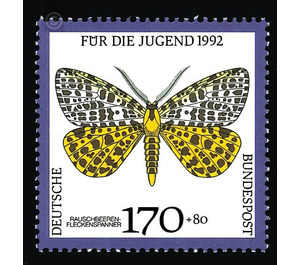youth: endangered moths - Germany / Federal Republic of Germany 1992 - 170 Pfennig
Theme: Animals
| Country | Germany / Federal Republic of Germany |
| Issue Date | 1992 |
| Face Value | 170.00 |
| Color | multi-colored white blue |
| Perforation | K 13 3/4 |
| Printing Type | Multicolor offset printing |
| Stamp Type | Postage stamp |
| Item Type | Stamp |
| Chronological Issue Number | 1479 |
| Chronological Chapter | GER-BRD |
| SID | 323680 |
| In 28 Wishlists | |
Whoever speaks of butterflies usually means the colorful, flower-visiting butterflies that fly in the sunshine during the day, such as the peacock's eye, the little fox or the cabbage white. Few know that about nine-tenths of all butterflies belong to the so-called "moths." However, this is a rather inaccurate (and unscientific) collective term that encompasses everything that is not just "butterflies", a vast, heterogeneous set of at least 150,000 species worldwide, to which about 60 different "families" are assigned (for comparison: butterflies, for example) 13,000 species, 5 families). The only thing they have in common is their nocturnal way of life (and even that is far from being the case in every species, as many have become diurnal again). The fact that they fly around at night, being lured by light sources and sometimes getting into apartments, is probably the main reason why this large group of insects has either remained largely unknown to the layman or even occasional encounters with these "moths" are considered unpleasant, though they are completely harmless. Hardly anyone knows, therefore, the splendor and beauty of many species, at least comparable to the butterflies, or the subtle aesthetics of the other, less conspicuously colored species. There are more than 2,000 species of moths in Germany and of course they are - as well as the butterflies - endangered by human interference in the natural environment and threatened in part their existence. That they, too, are an indispensable and worthy part of a whole, to which, last but not least, man belongs, is to draw attention to the small selection of native moths. Also the »Spanner« (Geometridae) are with about 20,000 species described worldwide an extremely successful butterfly family. Its name - both German and Latin - was given to this family of butterflies by the particular manner of locomotion of their elongated caterpillars: they move "exciting" or "earth-measuring" by pulling the rear end close to the front end, craning the middle of the body then stretch again, with the back legs clasped. The Raspberry Spot Spanner (Arichanna melanaria) is a pronounced habitat specialist. Like the bog-bunting under the butterflies, it inhabits exclusively the fringes of ombrotrophic bogs and also has the same caterpillar plant: the ruffberry (Vaccinium uliginosum). The yellow, covered with black, wavy vertical stripes caterpillar lives from September - overwintering - until May at this plant. The showy moth flies mainly in the months of July and August. Hazard factors: peat extraction, moor drainage.


